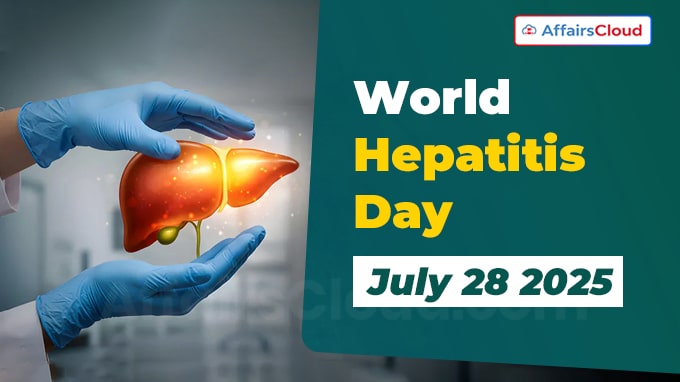 World Hepatitis Day (WHD) is observed every year on 28 July across the globe to increase public awareness about viral hepatitis, a liver inflammation that can lead to serious liver diseases and liver cancer.
World Hepatitis Day (WHD) is observed every year on 28 July across the globe to increase public awareness about viral hepatitis, a liver inflammation that can lead to serious liver diseases and liver cancer.
- The day serves as a global platform to promote advocacy, education, and collaboration among governments, healthcare professionals, and the general public, aiming to accelerate efforts towards the elimination of viral hepatitis.
- July 28, 2025 marks the 15th observance of WHD, coordinated by the World Health Organization (WHO).
Theme:
- 2025 Theme: “Hepatitis: Let’s Break It Down”. It calls for urgent action to remove financial, social, systemic, and stigma-related barriers that impede hepatitis elimination and liver cancer prevention
- Elimination Goal by 2030: Focus on eliminating hepatitis as a public health threat by 2030 (90% reduction in new infections, 65% reduction in mortality).
History of World Hepatitis Day (WHD):
Origin: The first global World Hepatitis Day was observed on 19 May 2008, initiated by the World Hepatitis Alliance in collaboration with various patient groups.
Adoption: In May 2010, the 63rd World Health Assembly (WHA) held in Geneva, Switzerland, adopted the resolution WHA63.18 on viral hepatitis, officially designating 28 July as the date for annual WHD observance.
First Observance: The first WHO-recognised World Hepatitis Day was observed on 28 July 2011.
Why 28 July:
Significance: 28 July marks the birth anniversary of Dr. Baruch Samuel Blumberg, the American scientist and geneticist who discovered the Hepatitis B Virus (HBV) in 1967.
Development of the First Vaccine: In 1969, Dr. Blumberg and Dr. Irving Millman developed the first hepatitis B vaccine, created from a heat-treated form of the virus.
Recognition: In 1976, Dr. Blumberg and Dr. D. Carleton Gajdusek jointly received the Nobel Prize in Physiology or Medicine for their discoveries related to the origin and spread of infectious diseases.
Overview of Hepatitis:
What is Hepatitis? Hepatitis refers to inflammation of the liver caused by infectious viruses or non-infectious agents.
Types: There are five major types of hepatitis viruses: A, B, C, D, and E, with Types B and C being the most likely to cause chronic infections.
Causes: These viruses are the leading causes of liver cirrhosis, liver cancer, and hepatitis-related deaths.
Global Impact and Elimination Efforts of Hepatitis:
Global Burden : In 2022, 304 million people worldwide are living with chronic hepatitis B or C, with 6,000 new infections daily of hepatitis B and C emphasizing a silent and rising epidemic.
- Chronic hepatitis causes 1.3 million deaths per year, mainly due to cirrhosis and liver cancer, almost 3,500 daily deaths, comparable to tuberculosis mortality
Prevention: The WHO insists that the Policy Makers & Governments should Embed hepatitis programs into universal health coverage and national insurance schemes, including,
- Testing: Early detection is vital, get screened for hepatitis B and C, particularly if at high risk.
- Incorporate affordable testing and treatment into primary healthcare platforms, including maternal and child health services.
- Vaccination: Administer the hepatitis B vaccine dose within 24 hours of birth, followed by full immunization schedules.
- Expand birth-dose vaccination, ensure safe medical practices, and integrate harm reduction programs into public health systems
Goals: The WHO aims to eliminate viral hepatitis as a public health threat by 2030 under its Global Health Sector Strategy on Human immunodeficiency virus (HIV), Viral Hepatitis and Sexually Transmitted Infections (STIs) (2022–2030).
- This strategy targets a 90% reduction in new infections and a 65% reduction in hepatitis-related deaths, compared to 2015 levels
Conferences & Collaboration: In March 2025, the WHO participated in the 19th Global Hepatitis Summit in Los Angeles. The event reviewed progress towards the 2030 elimination targets and showcased innovations, research, and public health measures vital for viral hepatitis control
India’s Response to Hepatitis:
National Burden: Approximately 40 million people in India live with chronic hepatitis B, and another 6–12 million with hepatitis C
- Hepatitis B prevalence ranges between 2–4%, with higher rates in states like Bihar, Punjab, Haryana, Madhya Pradesh, and Odisha
National Initiatives:
- National Viral Hepatitis Control Program (NVHCP) launched in 2018 to reduce hepatitis-related illness and death via vaccination, screening of donated blood, and preventing mother-to-child transmission.
- Hepatitis B vaccination has significantly improved: third-dose coverage rose from 62.8% (NFHS-4) to 83.9% (NFHS-5) by 2023, although birth-dose coverage remains at approx.63%, and diagnostic and treatment coverage are still inadequate (diagnosis rate approx. 2.4%, treatment nearly 0%).
- Rapid diagnostic test kits (RDTs) for Hepatitis B are now being rolled out by Indian Council of Medical Research (ICMR) to rural health centres, improving early detection access.
- Indian Hepatitis Summit 2025 held in Chennai ,Tamil Nadu(TN) in January 2025, brought together experts from the WHO, Non-Governmental Organizations(NGOs), clinicians, and government to pledge a coalition commitment toward hepatitis elimination in India by 2030.
About World Health Organisation (WHO):
Director General(DG)- Dr Tedros Adhanom Ghebreyesus
Headquarters- Geneva, Switzerland
Established- 1948




